GMC SIERRA 1996 Owners Manual
Manufacturer: GMC, Model Year: 1996, Model line: SIERRA, Model: GMC SIERRA 1996Pages: 404, PDF Size: 21.57 MB
Page 321 of 404
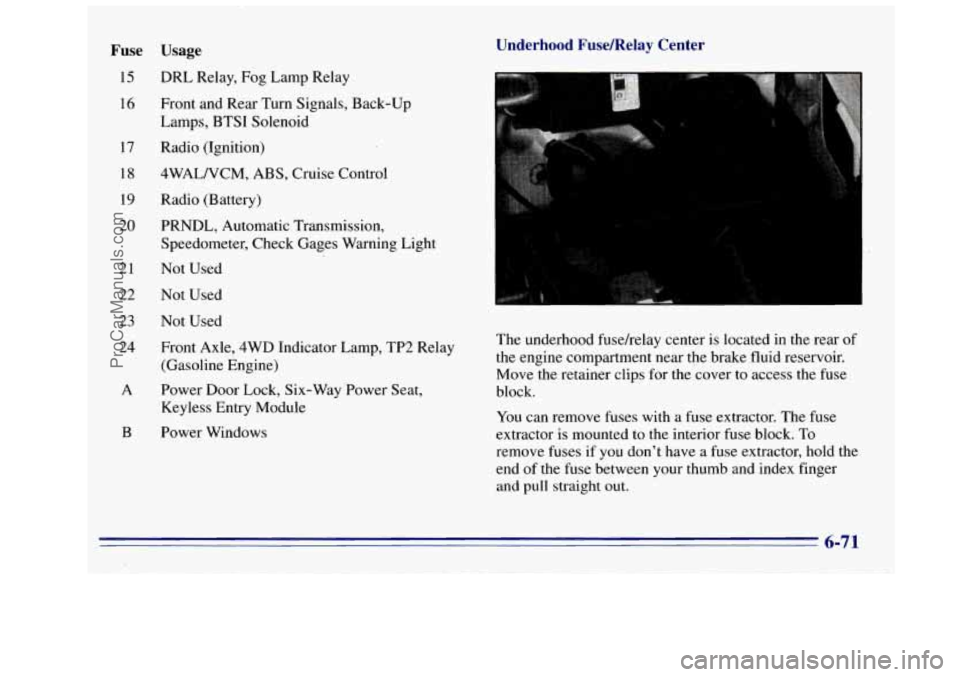
Fuse Usage
15 DRL Relay, Fog Lamp Relay
Underhood Fusemelay Center
16
17
18
19
20
21
22
23 24 Front and Rear Turn
Signals, Back-up
Lamps, BTSI Solenoid
Radio (Ignition)
4WALNCM, ABS, Cruise Control
Radio (Battery)
PRNDL, Automatic Transmission,
Speedometer, Check Gages Warning Light
Not Used
Not Used
Not Used
Front Axle, 4WD Indicator Lamp, TP2 Relay
(Gasoline Engine)
A Power Door Lock, Six-Way Power Seat,
Keyless Entry Module
B Power Windows The underhood
fusehelay center is located in the rear
of
the engine compartment near the brake fluid reservoir.
Move the retainer clips for the cover to access the fuse
block.
You can remove fuses with a fuse extractor. The fuse
extractor
is mounted to the interior fuse block. To
remove fuses if
you don’t have a fuse extractor, hold the
end of the fuse between your thumb and index finger
and
pull straight out.
6-71
ProCarManuals.com
Page 322 of 404
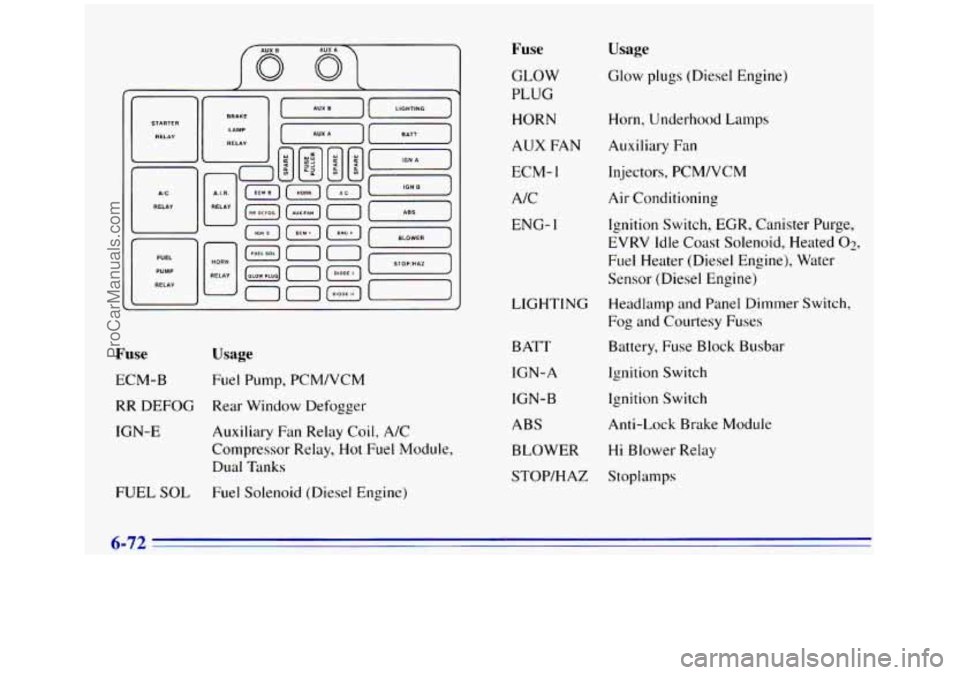
Fuse
ECM-B
Usage
Fuel Pump, PCM/VCM
RR DEFOG Rear Window Defogger
IGN-E Auxiliary Fan Relay Coil, A/C
Compressor Relay, Hot Fuel Module,
Dual Tanks
FUEL SOL Fuel Solenoid (Diesel Engine)
Fuse
GLOW
PLUG
HORN
AUX FAN
ECM-
1
A/C
ENG-
1
Usage
Glow plugs (Diesel Engine)
Horn, Underhood Lamps Auxiliary Fan
Injectors, PCM/VCM
Air Conditioning
Ignition Switch, EGR, Canister Purge,
EVRV Idle Coast Solenoid, Heated
02,
Fuel Heater (Diesel Engine), Water
Sensor (Diesel Engine)
LIGHTING Headlamp and Panel Dimmer Switch,
Fog and Courtesy Fuses
Battery,
Fuse Block Busbar
BATT
IGN-A
IGN-B
ABS Ignition Switch
Ignition Switch
Anti-Lock Brake Module
BLOWER
Hi Blower Relay
STOP/HAZ Stoplamps
ProCarManuals.com
Page 323 of 404
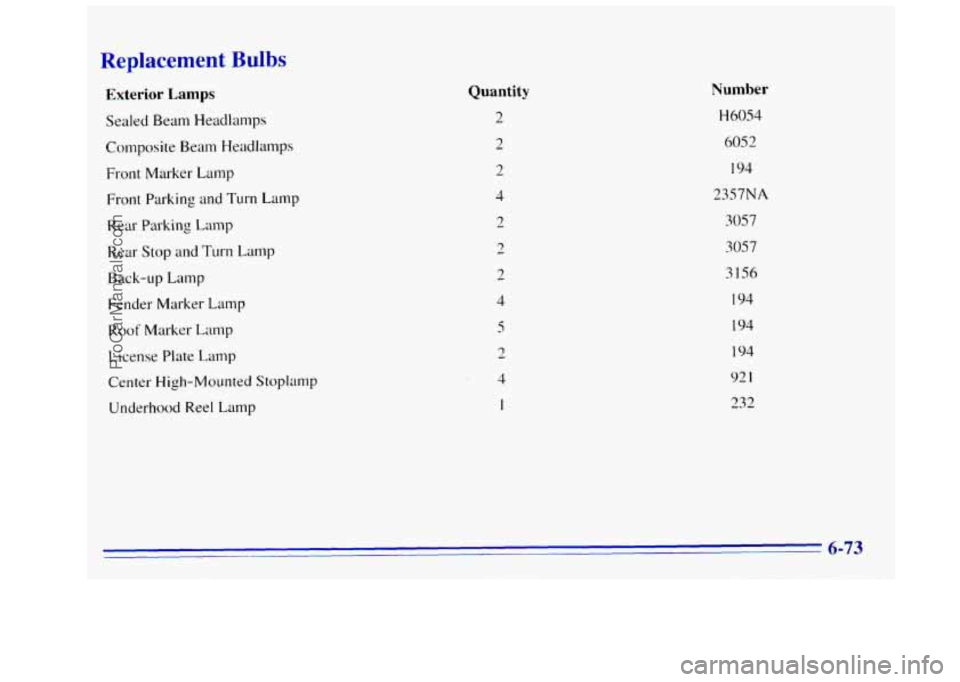
Replacement Bulbs
Exterior Lamps
Sealed Beam Headlamps
Composite Beam Headlamps
Front Marker Lamp Front Parking
and Turn Lamp
Rear Parking Lamp
Rear
Stop and Turn Lamp
Back-up Lamp
Fender Marker Lamp
Roof Marker Lamp
License Plate Lamp
Center High-Mounted Stoplamp Underhood Reel Lamp
Quantity
2
2
2
4
2
2
2
4
5
2
4
1
Number
H6054
6052
194
2357NA
3057
3057
3156
194
194
194
92 I
232
ProCarManuals.com
Page 324 of 404
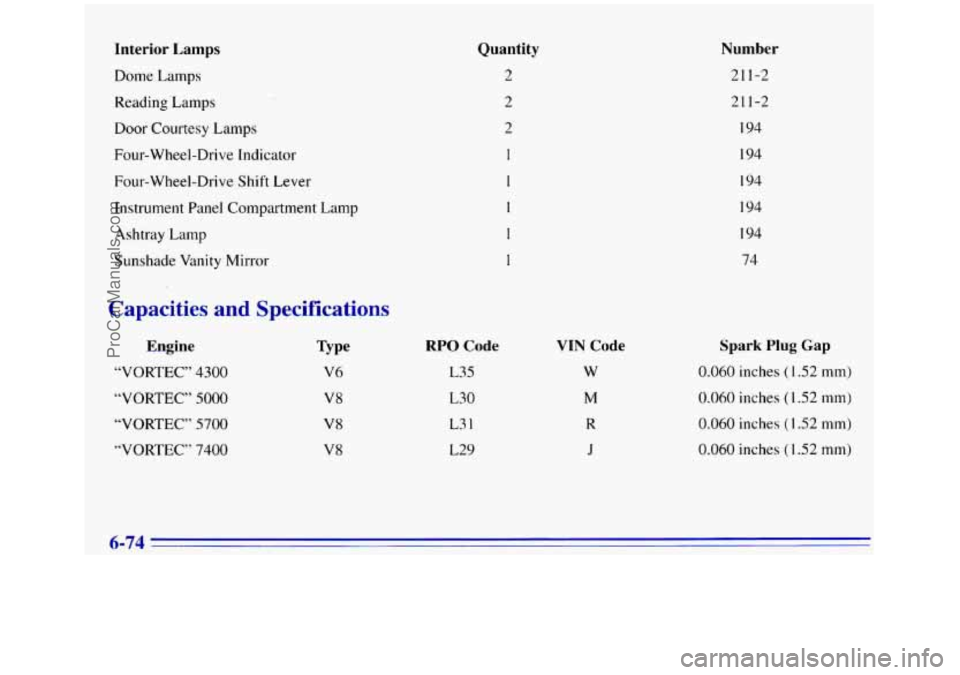
Interior Lamps
Dome Lamps
Reading ‘Lamps
Door Courtesy Lamps
Four-Wheel-Drive Indicator
Four-Wheel-Drive Shift Lever
Instrument Panel Compartment Lamp
Ashtray
Lamp
Sunshade Vanity Mirror
Capacities and Specifications
Engine
“VORTEC” 4300
“VORTEC” 5000
“VORTEC”
5700
“VORTEC” 7400
Type
V6
V8
V8
V8
Quantity
2
2
2
1
1
1
1
1
RPO Code
L35
L30
L3 1
L29
VIN Code
W
M
R
J
Number
21 1-2
21 1-2
194
194
194
194
194
74
Spark Plug Gap
0.060 inches ( 1.52 mm)
0.060 inches (1.52 mrn)
0.060 inches (1.52 mm)
0.060 inches (I -52 mm)
6-74
ProCarManuals.com
Page 325 of 404
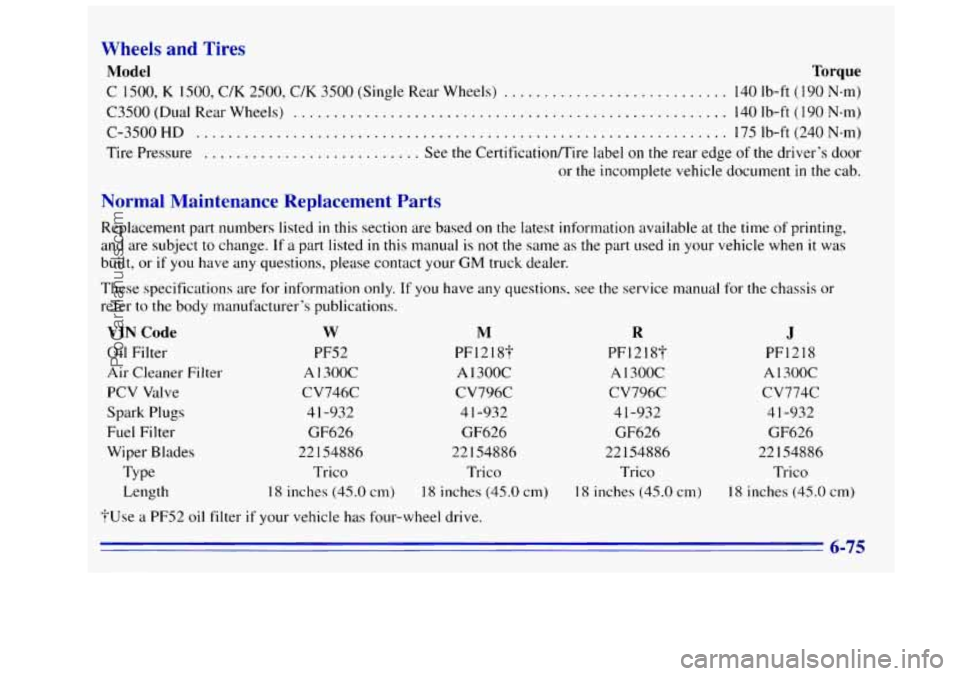
Wheels and Tires
Model Torque
C 1500, K 1500, C/K 2500, C/K 3500 (Single Rear Wheels) ............................ 140 Ib-ft (190 N-m)
C3500 (Dual
Rear Wheels) ...................................................... 140 Ib-ft (190 N-m)
Tire Pressure ........................... See the Certificationflire label on the rear edge of the driver's door
or the incomplete vehicle document in the cab.
C-3500HD
.................................................................. 175Ib-ft(240N-m)
Normal Maintenance Replacement Parts
Replacement part numbers listed in this section
are based on the latest information available at the time of printing,
and are subject to change.
If a part listed in this manual is not the same as the part used in your vehicle when it was
built, or
if you have any questions, please contact your GM truck dealer.
These specifications are
for information only. If you have any questions. see the service manual for the chassis or
refer
to the body manufacturer's publications.
VIN Code w M
Oil Filter PF52
PF1218T
Air
Cleaner Filter A 1300C A 1300C
PCV Valve CV746C CV796C
Spark Plugs 4 1-932 4 1-932
Fuel Filter GF626
GF626
Wiper Blades 22 154886 221 54886
Type Trico Trico
Length
18 inches (45.0 cm) 18 inches (45.0 cm)
?Use a PF52 oil filter if your vehicle has four-wheel drive.
R
PF1218T
A 130OC
CV796C
4 1-932
GF626
22 154886
Trico
18 inches (45.0 cm)
J
PF1218
A
1300C
cv774c
41 -932
GF626
22 154886
Trico
18 inches (45.0 cm)
6-75
ProCarManuals.com
Page 326 of 404
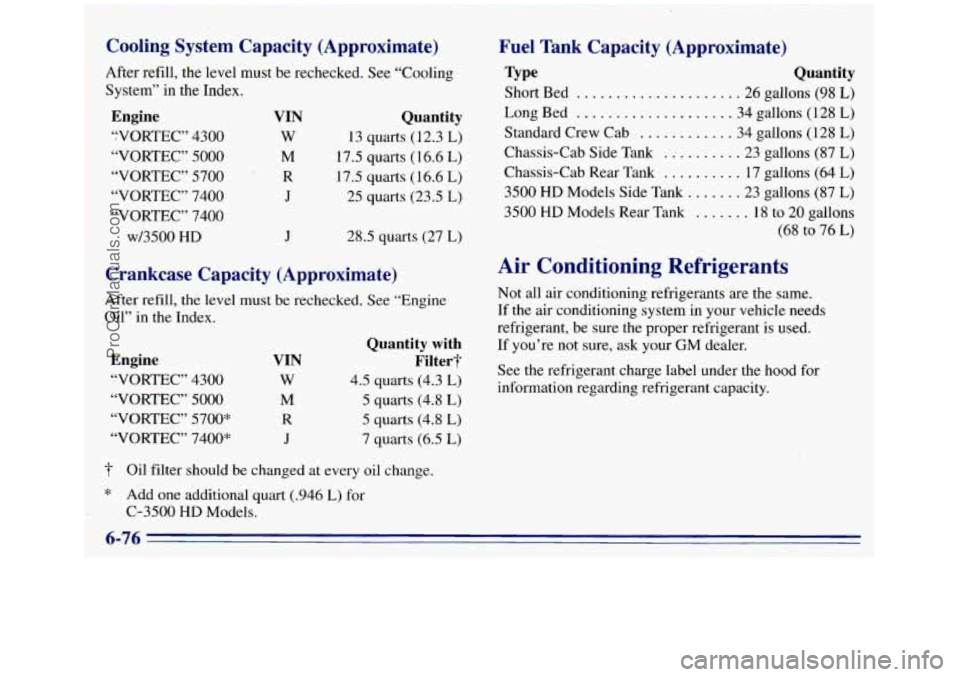
J 28.5 quarts (27 L)
Fuel Tank Capacity (Approximate)
Type Quantity
Short Bed .................... .26 gallons (98 L)
Long Bed ................... .34 gallons (128 L)
Standard Crew Cab ........... 34 gallons (128 L)
Chassis-Cab Side Tank . .I ........ 23 gallons (87 L)
Chassis-Cab Rear Tank .......... 17 gallons (64 L)
3500 HD Models Side Tank ....... 23 gallons (87 L)
3500 HD Models Rear Tank ....... 18 to 20 gallons
(68 to.76
L)
-Air Conditioning Refrigerants
Not all air conditioning refrigerants are the same.
If the air conditioning system in your vehicle needs
refrigerant, be sure the proper refrigerant is used.
If you’re not sure, ask your
GM dealer.
See the refrigerant charge label under the hood for
information regarding refrigerant capacity.
ProCarManuals.com
Page 327 of 404
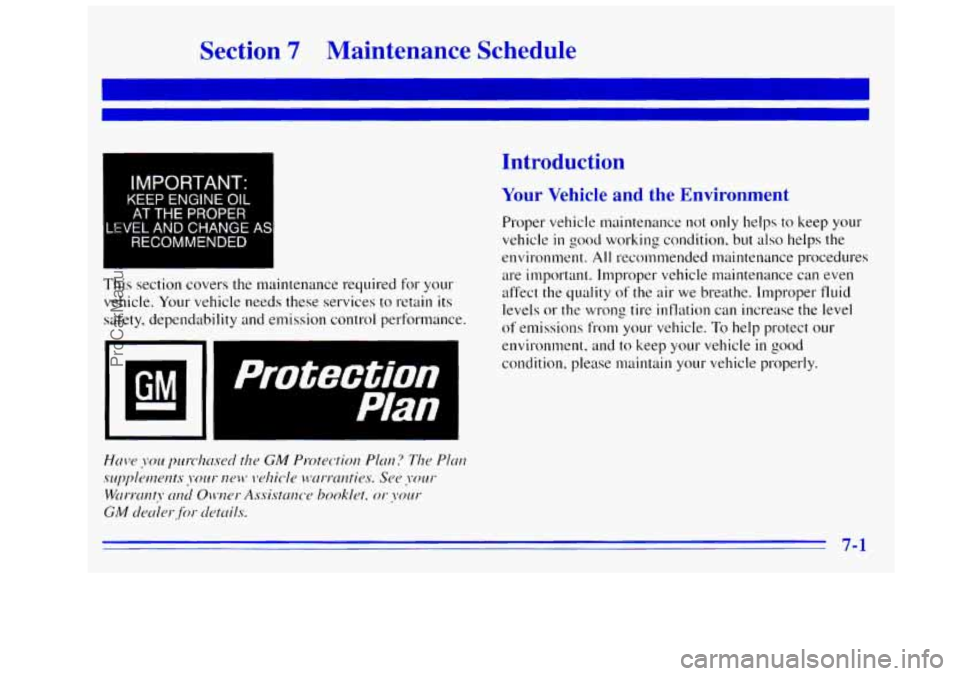
Section 7 Maintenance Schedule
I IMPORTANT: I
KEEP ENGINE OIL
AT THE PROPER
LEVEL AND CHANGE AS
RECOMMENDED
This section covers the maintenance required for your
vehicle. Your vehicle needs these services to retain its
safety, depe.ndability and emission control performance.
7- 1
Protection
Plan
Introduction
Your Vehicle and the Environment
Proper vehicle maintenance not only helps to keep your
vehicle
in good working condition. but also helps the
environment.
All 1-ecommended maintenance procedures
are important. Improper vehicle maintenance can even affect the quality of the air we breathe. Improper fluid
levels or the wrong
tire inflation can increase the level
of emissions fr6m your vehicle. To help protect our
environlnent, and to keep your vehicle in good
condition, please maintain your vehicle properly.
ProCarManuals.com
Page 328 of 404
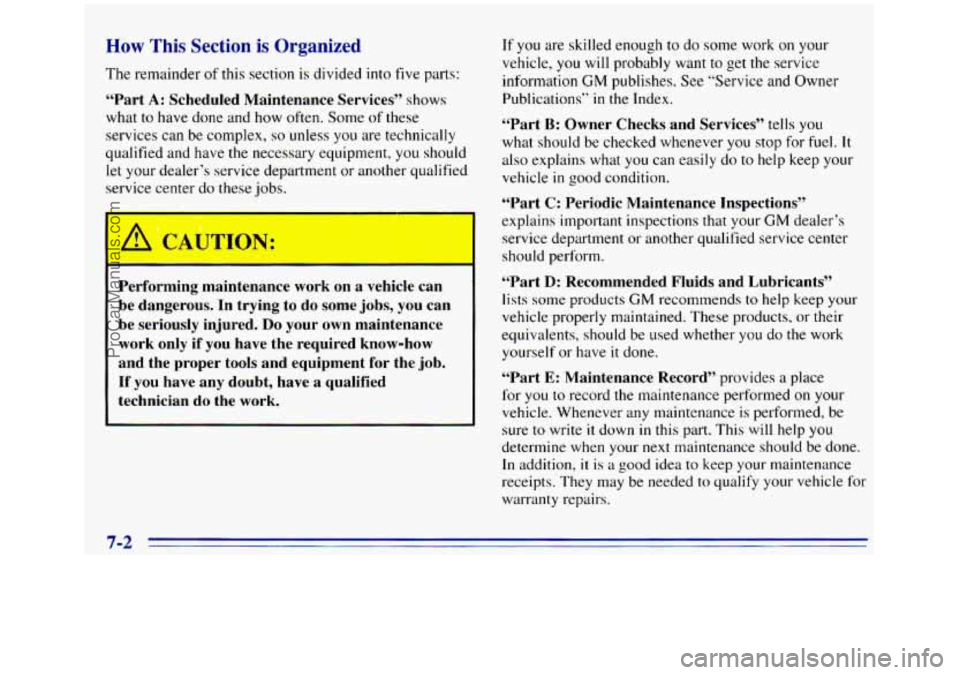
How This Section is Organized
The remainder of this section is divided into five parts:
“Part A: Scheduled Maintenance Services’’ shows
what to
have done and how often. Some of these
services can be complex, so unless you are technically
qualified and have
the necessary equipment, you should
let
your dealer’s service department or another qualified
service center do these jobs.
Performing ma~ntenance worK on a vehicle can
be dangerous. In trying to do
some jobs, you can
be seriously injured.
Do your own maintenance
work only
if you have the required know-how
and the proper tools and equipment for the
job.
If you have any doubt, have a qualified technician do the work.
If you are skilled enough to do some work on your
vehicle, you will probably want to get the service
information
GM publishes. See “Service and Owner
Publications”
in the Index.
“Part B: Owner Checks and Services” tells you
what should be checked whenever you stop for fuel.
It
also explains what you can easily do to help keep your
vehicle
in good condition.
“Part C: Periodic Maintenance Inspections”
explains important inspections that your GM dealer’s
service department
or another qualified service center
should perform.
“Part D: Recommended Fluids and Lubricants”
lists some products GM recommends to help keep your
vehicle properly maintained. These products, or their
equivalents, should be used whether you do the work
yourself or have
it done.
“Part E: Maintenance Record” provides a place
for you to record the maintenance performed
on your
vehicle. Whenever any maintenance
is perf‘ormed, be
sure to write
it down in this part. This will help you
determine when your
next maintenance should be done.
In addition, it is a good idea to keep your maintenance
receipts. They may
be needed to qualify your vehicle for
warranty repairs.
7-2
ProCarManuals.com
Page 329 of 404
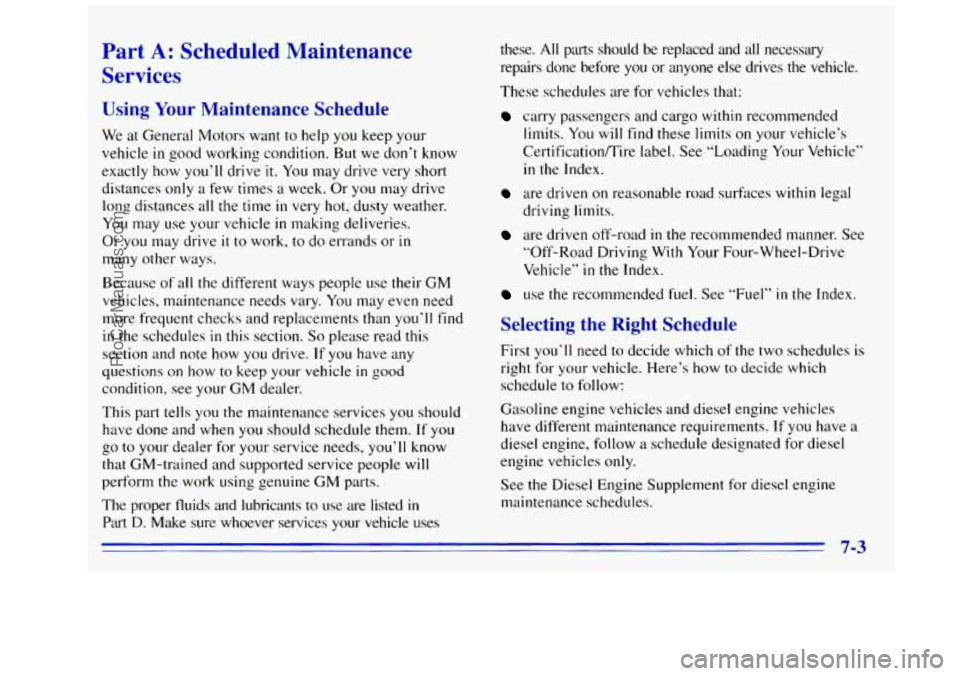
Part A: Scheduled Maintenance
Services
Using Your Maintenance Schedule
We at General Motors want to help you keep your
vehicle
in good working condition. But we don’t know
exactly how you’ll drive
it. You may drive very short
distances only a few times a week. Or
you may drive
long distances all the time
in very hot, dusty weather.
You may use your vehicle in making deliveries.
Or you may drive
it to work, to do errands or in
many other ways.
Because
of all the different ways people use their GM
vehicles, maintenance needs vary. You may even need
more frequent checks and replacements than you’ll find
in the schedules in this section. So please read this
section and note how
you drive. If you have any
questions on
how to keep your vehicle in good
condition, see your GM dealer.
This part tells
you the maintenance services you should
have done and when
you should schedule them. If you
go to your dealer for your service needs, you’ll know
that GM-trained and supported service people will
perform the work using genuine GM parts.
The proper fluids and lubricants to
use are listed in
Part D. Make sure whoever services your vehicle uses these.
All parts should be replaced and all necessary
repairs done before
you or anyone else drives the vehicle.
These schedules are for vehicles that:
carry passengers and cargo within recommended
limits. You will find these limits
on your vehicle’s
CertificatiodTire label. See “Loading Your Vehicle”
in the Index.
are driven on reasonable road surfaces within legal
driving limits.
are driven off-road in the recommended manner. See
”Off-Road Driving With Your Four-Wheel-Drive
Vehicle”
in the Index.
use the recommended fuel. See “Fuel” in the Index.
Selecting the Right Schedule
First you’ll need to decide which of the two schedules is
right for your vehicle.
Here’s how to decide which
schedule
to follow:
Gasoline engine vehicles and diesel engine vehicles
have different maintenance requirements.
If you have a
diesel engine, follow a schedule designated
for diesel
engine vehicles only.
See the Diesel Engine Supplement for diesel engine
maintenance schedules.
7-3
ProCarManuals.com
Page 330 of 404
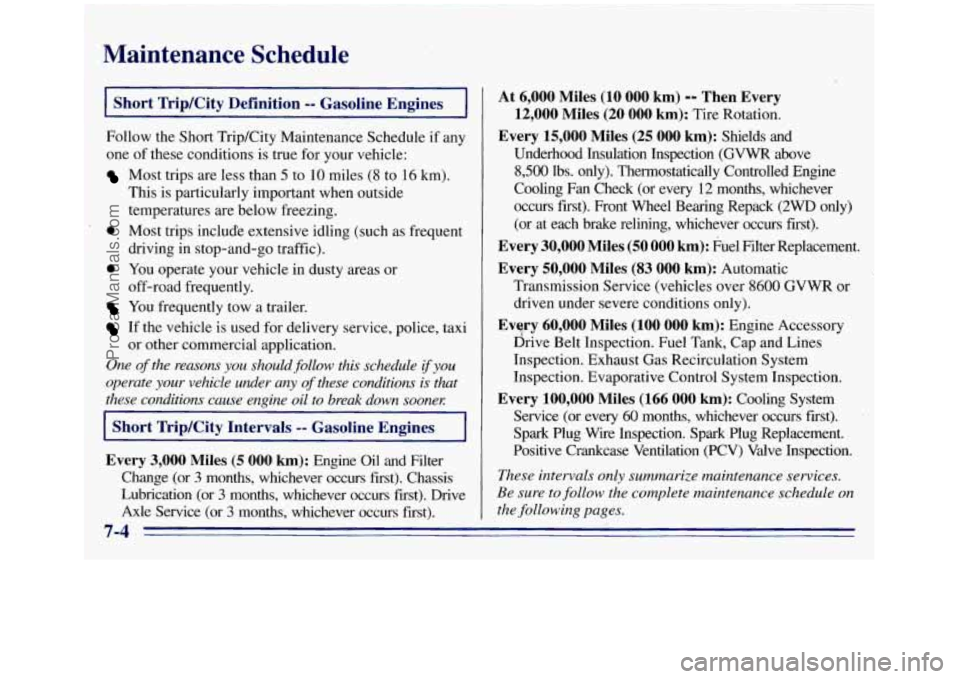
Maintenance Schedule
I Short Trip/City Definition -- Gasoline Engines . I ~
Follow the Short Trip/City Maintenance Schedule if any
one of these conditions is true for your vehicle:
Most trips are less than 5 to 10 miles (8 to 16 km).
This is particularly important when outside
temperatures are below freezing.
driving in stop-and-go traffic).
off-road frequently.
0 Most trips include extensive idling (such as frequent
0 You operate your vehicle in dusty areas or
You frequently tow a trailer.
If the vehicle is used for delivery service, police, taxi
One of the reasons you should follow this schedule if you
operate your vehicle under any of these conditions is that
these conditions cause engine oil to break down soonez
or other commercial application.
I Short Trip/City Intervals -- Gasoline Engines I
Every 3,000 Miles (5 000 km): Engine Oil and Filter
Change
(or 3 months, whichever occurs first). Chassis
Lubrication (or
3 months, whichever occurs first). Drive
Axle Service (or
3 months, whichever occurs first).
At 6,000 Miles (10 000 km) -- Then Every
12,000 Miles (20
000 km): 'Tire Rotation.
Every 15,000 Miles (25 000 km): Shields and
Underhood Insulation Inspection
(GVWR above
8,500 lbs. only). Thermostatically Controlled Engine
Cooling Fan Check (or every
12 months, whichever
occurs first). Front Wheel Bearing Repack
(2WD only)
(or at each brake relining, whichever occurs first).
Every 30,000 Miles (50 000 km): Fuel Filter Replacement.
Every 50,000 Miles (83 000 km): Automatic
Transmission Service (vehicles over
8600 GVWR or
driven under severe conditions only).
Evwy 60,000 Miles (100 000 km): Engine Accessory
Drive Belt Inspection. Fuel Tank, Cap and Lines
Inspection. Exhaust Gas Recirculation System
Inspection. Evaporative Control System Inspection.
Every 100,000 Miles (166 000 km): Cooling System
Service (or every
60 months, whichever occurs first).
Spark Plug Wire Inspection. Spark Plug Replacement.
Positive Crankcase Ventilation
(PCV) Valve Inspection.
These intervals only summarize maintenance services.
Be sure to follow the complete maintenance schedule
on
the following pages.
7-4
ProCarManuals.com